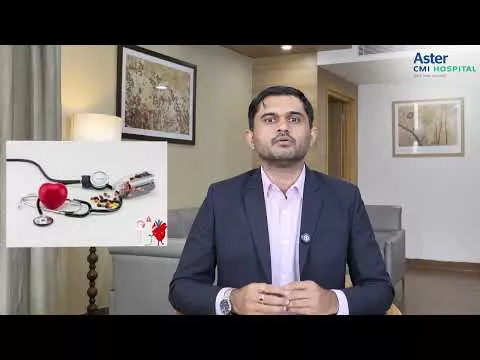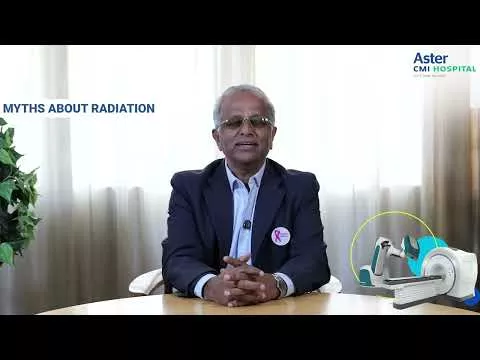Technological Highlights: Department of Radiation Oncology
Inter-disciplinary approach in cancer is essential for the optimum outcomes. Today’s oncology treatment is technology, data and experience-driven in the background of international guidelines. However, both hard and soft advanced technology is not the only necessity, but the appropriate and timely combination of this technology with various cancer and patient conditions is the art of oncological practice. Following are the examples of vision of the Department of Radiation Oncology of Aster CMI.
1. Liver Team - "Bridge to Liver Transplant":
Liver transplant is the modality is used in an attempt to cure HCC (Hepato-Cellular Cancer) which is the commonest liver cancer. Once the liver transplant is decided for a particular patient, it may not be possible to go ahead with the procedure immediately. Bridge to liver transplant is the strategy of restraining the liver cancer till the patient is ready for the liver transplant which may take as much as 3 to 6 months. Here, the latest technology of radiotherapy, Stereotactic Radiotherapy (SBRT), also known as Stereotactic Ablative Body Radiotherapy (SABR) is advised.
This can be combined with Trans-Arterial Chemo-Embolization (TACE) or Micro-Wave / radiofrequency (RFA) ablation since SBRT/SABR works better when combined. One more potential advantage of this strategy is the selection of proper patients for a liver transplant when no disease appears elsewhere during the period of waiting.
With advances in immunotherapy, combined SABR/SBRT is the other highlight of technology, since SABR/SBRT also has immunological effects.
2. Paediatric Oncology Team:
a. TBI (Total Body Irradiation)
b. Paediatric Auto-immune disorders: Low Dose TBI (Low Dose Total Body Irradiation)
TBI is an established procedure for preparing for bone marrow transplant in selected situations, especially in children with blood cancer. Recently, there has been increasing use of TBI in low doses for children with autoimmune disorder prior to bone marrow transplant.
3. Neurosurgery Team:
a. Tractography in Rapid Arc IGRT Planning of Brain Tumours
b. Tractography & Fluorescein Navigation Guided Excision of brain cancer
c. Hippocampal Sparing Rapid Arc IGRT in Whole Brain RadioTherapy (WBRT)
Improving MRI technology has contributed immensely in mapping the tumour, especially in brain cancers. Cancer can spread locally in the brain along the nerve fibres for variable distance and also press on the nerve fibres or break them. Tractography is one of the fast-developing MRI imaging and helps in identifying the pattern of disruption of the nerve tracts by cancer while planning for both surgery (along with Fluorescein Guided Navigation) & radiotherapy, especially with High Definition Tractography in the horizon.
In the present era, when cancer spreads to the brain from the body, in the majority of the situations only cancer lumps are targeted with advanced radiotherapy technique of Stereotactic Radiosurgery (SRS). However, sometimes, when the lumps are too many, the age-old technique of treating the entire brain is required. In such an event, to minimize the effects on the memory (cognitive ability) two spots in both sides of the brain, called the hippocampus, are excluded from the prescription dose of radiation (if they are not affected by cancer). This is the technique of hippocampal sparing Rapid Arc IGRT at our centre.
4. Medical Oncology Team:
Multiple site SBRT (Stereotactic Body Radio Therapy) / SABR (Stereotactic Ablative Body Radiotherapy) in limited Stage IV cancers (Oligometastases) without or with Immunotherapy
There is nothing, more important than proper synchronization of radiotherapy and chemotherapy/immunotherapy in cancer treatment when given. A new thing in radiotherapy use of SBRT/SABR even with stage IV cancer with the intent of long-term control, if not cure. In stage IV there is a situation between cancer that has not spread elsewhere and cancer spread everywhere in the body. This condition where cancer has spread to the limited number of sites or reduces to a limited number of sites after initial treatment with chemotherapy/ immunotherapy is called Oligometastases. SBRT/SABR is a valid treatment now with the intent to long-term control. Also, there is a possibility that both will improve the effectiveness of the other, when not effective individually.
5. Urology Team:
Prostate Cancer - Prostate Cancer: Beam Hold Technique tracking of cancer with gold fiducials in the prostate for Rapid Arc IGRT or SBRT.
One technique to further minimize the radiation dose to the normal tissue is tracking the cancer lump since it can minimally move during the treatment in some sites. One example is prostate. The present-day machine on treatment time has become very short (within 3 minutes) to take care of this possibility. To further improve the results, grain-like gold “seeds” are inserted using ultrasound guidance and use it to monitor the possible shift during the treatment especially in the SBRT of the prostate. The treatment beam shuts of within fraction of seconds when moving beyond the specified mm is detected.
6. Radiology Team: Mapping the Cancer
Here is the situation of truly interdisciplinary management of cancer. Specialized radiologists have an invaluable contribution in mapping the cancer tissue for precise planning and delivery of advanced radiation techniques.
7. General
a. 6D Robotic sub-millimetre correction accuracy during Routine IMRT (Intensity Modulated Radiotherapy) and Rapid Arc IGRT (Image Guided RadioTherapy).
b. DIBH (Deep Inspiratory Breath-Hold) technique in the treatment of left-sided breast cancer and lung cancers.
c. 4D CT scan technique in the treatment of lung cancers.
d. Abdominal compression SBRT/SABR in the liver and other upper abdomen cancers.





